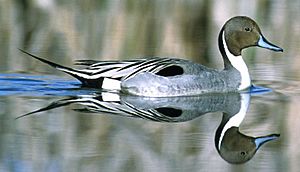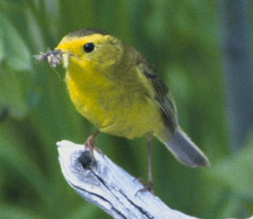British avifauna facts for kids
The birds of Britain are all the different kinds of birds that live in or visit Great Britain. This article will tell you about them. You can find a full list of all the bird species in Britain at List of birds of Great Britain.
Britain's birds are a lot like those found across Europe. Most of them are from the Palaearctic region, which covers Europe and Asia. Because Britain is an island, it has fewer types of birds that breed there compared to mainland Europe. Some birds, like the crested lark, live just across the English Channel in northern France but haven't made it to Britain.
Britain has mild winters. This means many birds that can't handle very cold weather come to Britain for the winter. Lots of birds also fly in from Europe or even further away to spend the colder months here.
Around 250 bird species are seen regularly in Great Britain. Another 350 species visit less often, some of them being very rare.
Contents
Birds That Live Here All Year Round
About 120 bird species stay in Great Britain all year long. Some of these birds, like the tawny owl or red grouse, live here permanently and don't migrate. Other birds, like the common starling, have their numbers grow in winter when more birds arrive from Europe. Some, like the European goldfinch, might fly to Ireland or southern Europe if the winter gets too harsh.
Many waders, such as the ringed plover and dunlin, both breed and spend the winter in Britain. For most other bird populations, their breeding and wintering areas are different.
The black-tailed godwit is an interesting example. Even though you can see them all year, the birds that breed in Britain actually fly south for winter. Then, new black-tailed godwits from Iceland arrive to spend the winter in Britain.
Visiting Birds
Summer Visitors: Birds That Breed Here
About 60 bird species are mainly summer visitors. They come to Britain to breed and then fly south for the winter, mostly to Africa. Many of these birds eat insects, like warblers, flycatchers, and the common cuckoo. This makes sense because there are not many insects around in British winters.
Several seabirds move out to sea after they finish breeding. Terns and some auks are not seen in Britain during the winter months.
In 2007, 16 million birds flew from Africa to Britain. Sadly, the numbers of some of these birds have dropped a lot. For example, swifts declined by 40% between 1994 and 2007. Nightingales were down 60% since 1994, and wood warblers were down 67%. Turtle doves declined by 66%, spotted flycatchers by 59%, and cuckoos by 37%.
Winter Visitors: Birds That Come for Warmth

Britain's mild winters are very appealing to about 60 species of birds that breed further north. These are often larger birds like swans, geese, ducks, gulls, and thrushes. But some smaller birds, such as the snow bunting and brambling, also arrive in large numbers.
The number of some birds, like the Bohemian waxwing, can change a lot each year. This depends on how much food is available and how many birds there are in their breeding areas.
Passage Migrants: Birds Just Passing Through
Some bird species don't usually breed or spend winter in Great Britain. Instead, they just pass through during their long migrations. Often, many of these birds can be seen. Arctic breeding waders are a good example. Species like the little stint and curlew sandpiper are usually quite common as they pass through.
The number of some passage birds depends on the weather. For example, you might see more visitors from the Mediterranean like hoopoes and Alpine swifts in spring. This happens if winds from the south push them past their usual breeding areas.
In both spring and autumn, the number of birds breeding in Scandinavia, such as the bluethroat and wryneck, is linked to how often easterly winds blow.
A few seabirds also fit into this group. They breed in the southern part of the world but "winter" in the northern part during our summer. These birds are seen off the southwest of Britain in autumn. They include the great shearwater, sooty shearwater, and the rare Wilson's petrel.
Rarities: Unexpected Visitors

One exciting thing about the list of British birds is the number of rare visitors. Because Britain is on the western edge of Europe, it gets many birds that have wandered off course from North America. Some American gulls, ducks, and waders visit often enough that they are not considered super rare. These include the ring-billed gull, surf scoter, and pectoral sandpiper. Rare American songbirds (passerines) include the red-eyed vireo and blackpoll warbler.
Some rare birds breed in Europe but are short-distance migrants. They rarely make it to Great Britain. Examples are the crested lark and Marmora's warbler.
Birds from Siberia, like the yellow-browed warbler and Pechora pipit, also appear more often in Britain than further east in Europe. This is because migrating birds often stop to rest on Britain's eastern coast after crossing the North Sea.
Only one bird that breeds only south of the Sahara desert has reached Britain, and it has done so twice. This is Allen's gallinule.
Rare seabirds can travel huge distances to reach Britain. One of the most surprising birds to wander to Britain is the ancient murrelet from the Pacific Ocean.
Introduced Species: Birds Brought Here by People
Britain's climate isn't ideal for lots of introduced species, unlike warmer places like Florida. However, there are nine types of birds that have been brought to Britain and now have wild populations that can support themselves. Also, there are wild groups of Canada goose, greylag goose, and other wildfowl that would be on the British bird list anyway because of wild breeders or visitors.
The introduced species that are now part of the British bird list are:
- Egyptian goose, Alopochen aegyptiacus
- Ruddy duck, Oxyura jamaicensis
- Mandarin, Aix galericulata
- Red-legged partridge, Alectoris rufa
- Golden pheasant, Chrysolophus pictus
- Lady Amherst's pheasant, Chrysolophus amherstiae
- Common pheasant, Phasianus colchicus
- Rose-ringed parakeet, Psittacula krameri
- Little owl, Athene noctua
The Western capercaillie, Tetrao urogallus, and white-tailed eagle, Haliaeetus albicilla, are examples of reintroductions. This means they used to breed in Britain, disappeared, and then people brought them back.

